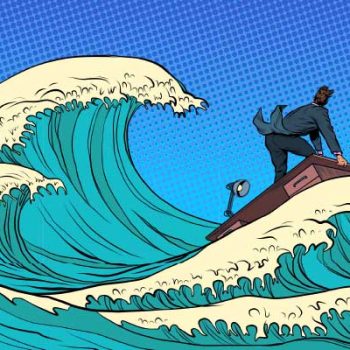What counts is how your money is invested now in anticipation of rate hikes
At their recent March meeting, the Federal Reserve moved its fed funds target rate from near zero to a range of 0.25% to 0.50%. It was the first rate hike since 2018.
But the Fed did three more things too, including:
- Releasing an updated forecast which showed that we can expect the Fed to raise rates about 7 times in 2022.
- Downgrading their forecast for economic growth, while upwardly revising inflation projections.
- Suggesting that it would shift its monetary policy from accommodative to neutral and then to slightly restrictive before the end of 2023.
And Wall Street seemed ok with this approach and as soon as the Fed’s meetings concluded, markets jumped.
The Fed – In Their Own Words
“Indicators of economic activity and employment have continued to strengthen. Job gains have been strong in recent months, and the unemployment rate has declined substantially. Inflation remains elevated, reflecting supply and demand imbalances related to the pandemic, higher energy prices, and broader price pressures.
The invasion of Ukraine by Russia is causing tremendous human and economic hardship. The implications for the U.S. economy are highly uncertain, but in the near term the invasion and related events are likely to create additional upward pressure on inflation and weigh on economic activity.
The Committee seeks to achieve maximum employment and inflation at the rate of 2 percent over the longer run. With appropriate firming in the stance of monetary policy, the Committee expects inflation to return to its 2 percent objective and the labor market to remain strong. In support of these goals, the Committee decided to raise the target range for the federal funds rate to 1/4 to 1/2 percent and anticipates that ongoing increases in the target range will be appropriate. In addition, the Committee expects to begin reducing its holdings of Treasury securities and agency debt and agency mortgage-backed securities at a coming meeting.
In assessing the appropriate stance of monetary policy, the Committee will continue to monitor the implications of incoming information for the economic outlook. The Committee would be prepared to adjust the stance of monetary policy as appropriate if risks emerge that could impede the attainment of the Committee’s goals. The Committee’s assessments will take into account a wide range of information, including readings on public health, labor market conditions, inflation pressures and inflation expectations, and financial and international developments.”
The Fed Was Not Unanimous
By its own metrics, however, it was becoming increasingly difficult for the Fed to forestall a rate increase at least in the range of 0.25%.
In fact, buried in a footnote of the Fed’s statement was this nugget:
“Voting against this action was James Bullard, who preferred at this meeting to raise the target range for the federal funds rate by 0.5 percentage points to 1/2 to 3/4 percent.”
Positioning a Portfolio for Rate Hikes
In the market’s grand scheme, what do additional rate hikes mean to the average investor?
Most financial advisors (and the authors of “Invest with the Fed: Maximizing Portfolio Performance by Following Federal Reserve Policy”) agree that, for average investors, what counts is how their money is invested now in anticipation of a rate hike.
A good strategy most advisors start with is to hold onto long-term equity positions if nothing has fundamentally changed regarding one’s long-term objectives. A sudden drop in prices, though, is not necessarily a negative for those long-term investors who favor buying more shares on a downturn at opportunistic lower prices. Historically, modestly rising rates have also correlated with higher price/earnings ratios – a key gauge for evaluating near-term stock price levels.
However, if a person could not withstand a 5% to 10% correction over the short-term, the time to liquidate shares is probably now, the authors of “Invest with the Fed” maintain. The best time to evaluate one’s ability to handle risk is prior to a rate hike – not after.
For Income-Minded Investors, Think Shorter Durations
For bond investors who need to spend the income from their investments, on the other hand, the time may be right for shortening durations. If rates gradually increase, downward pressure on bond prices will inevitably ratchet up too. For fixed income investors who plan to hold onto their bonds until they mature, there would be no need to redeploy assets to the shorter-end of the duration spectrum.
For investors with a bit of gumption, a rising rate environment can be supportive for a diversification move that includes commodities, precious metals and other inflation-resistant assets.
Talk to Your Financial Advisor
Investors need not ponder their rate hike concerns alone. In preparation for gradually rising rates, the time is probably right to meet with a financial advisor to review current allocations to make sure that holdings are appropriately diversified and still reflect your risk tolerance and financial goals.



